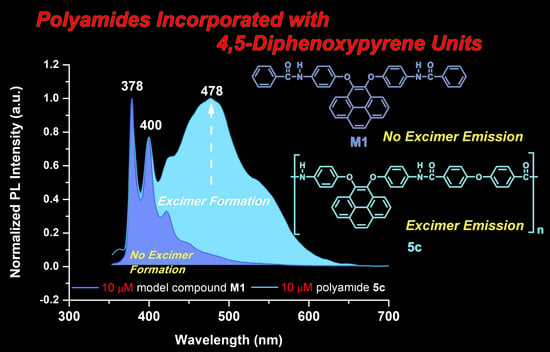Synthesis and Excimer Formation Properties of Electroactive Polyamides Incorporated with 4,5-Diphenoxypyrene Units
Abstract
:1. Introduction
2. Materials and Methods
2.1. Materials
2.2. Methods
3. Results and Discussion
3.1. Synthesis of Intermediates and Monomer
3.2. Polyamides Synthesis
3.3. Basic Characterization
3.4. Thermal Properties
3.5. Photophysical Properties
3.6. Electrochemical Data of Polyamides
4. Conclusions
Supplementary Materials
Author Contributions
Funding
Institutional Review Board Statement
Informed Consent Statement
Data Availability Statement
Acknowledgments
Conflicts of Interest
References
- Yang, H.H. Aromatic High-Strength Fibers; John Wiley & Sons, Inc.: New York, NY, USA, 1989. [Google Scholar]
- Morgan, P.W. Synthesis and properties of aromatic and extended chain polyamides. Macromolecules 1977, 10, 1381–1390. [Google Scholar] [CrossRef]
- Trigo-Lopez, M.; Estevez, P.; San-Jose, N.; Gomez-Valdemoro, A.; Garcia, F.C.; Serna, F.; de la Pena, L.J.; Garcia, J.M. Recent Patents on Aromatic Polyamides. Recent Pat. Mater. Sci. 2009, 2, 190–208. [Google Scholar] [CrossRef]
- Cassidy, P.E. Thermally Stable Polymers Syntheses and Properties; Marcel Dekker: New York, NY, USA, 1980. [Google Scholar]
- Dine-Hart, R.A.; Moore, B.J.; Wright, W.W. Aromatic polyamides. J. Polym. Sci. Part B 1964, 2, 369–373. [Google Scholar] [CrossRef]
- Imai, Y. Synthesis of novel organic-soluble high-temperature aromatic polymers. High Perform. Polym. 1995, 7, 337–345. [Google Scholar] [CrossRef]
- García, J.M.; García, F.; Serna, C.F.; de la Pena, L.J. High-performance aromatic polyamides. Prog. Polym. Sci. 2010, 35, 623–686. [Google Scholar] [CrossRef]
- Marchildon, K. Polyamides—Still strong after seventy years. Macromol. Mater. Eng. 2011, 5, 22–54. [Google Scholar] [CrossRef]
- Jikei, M.; Kakimoto, M. Dendritic aromatic polyamides and polyimides. J. Polym. Sci. Part A Polym. Chem. 2004, 42, 1293–1309. [Google Scholar] [CrossRef]
- Reglero Ruiz, J.A.; Trigo-López, M.; García, F.C.; García, J.M. Functional aromatic polyamides. Polymers 2017, 9, 414. [Google Scholar] [CrossRef] [Green Version]
- Hsiao, S.H.; Liou, G.S.; Kung, Y.C.; Pan, H.Y.; Kuo, C.H. Electroactive aromatic polyamides and polyimides with adamantylphenoxy-substituted triphenylamine units. Eur. Polym. J. 2009, 45, 2234–2248. [Google Scholar] [CrossRef]
- Chang, C.W.; Liou, G.S.; Hsiao, S.H. Highly stable anodic green electrochromic aromatic polyamides: Synthesis and electrochromic properties. J. Mater. Chem. 2007, 17, 1007–1015. [Google Scholar] [CrossRef]
- Kim, S.Y. Soluble wholly aromatic polyamides containing unsymmetrical pyridyl ether linkages. Polymer 2006, 47, 547–552. [Google Scholar]
- Ghaemy, M.; Nasab, S.M.A.; Alizadeh, R. Synthesis and characterization of new soluble polyamides from an unsymmetrical diamine bearing a bulky triaryl pyridine pendent group. J. Appl. Polym. Sci. 2010, 116, 3725–3731. [Google Scholar] [CrossRef]
- Sweileh, B.A.; Khalili, F.I.; Hamadneh, I.; Al-Dujaili, A.H. Synthesis and characterization of new polyamides containing symmetrical and unsymmetrical thiadiazole rings. Fibers Polym. 2016, 17, 166–173. [Google Scholar] [CrossRef]
- Barghamadi, M. Synthesis of aromatic, soluble, and thermally stable polyamides derived from new diamine containing unsymmetrical phenolphthalein and imidazole pendent group. High Perform. Polym. 2018, 30, 1260–1266. [Google Scholar] [CrossRef]
- Winnik, F.M. Photophysics of preassociated pyrenes in aqueous polymer solutions and in other organized media. Chem. Rev. 1993, 93, 587–614. [Google Scholar] [CrossRef]
- Manandhar, E.; Wallace, K.J. Host–guest chemistry of pyrene-based molecular receptors. Inorg. Chim. Acta 2012, 381, 15–43. [Google Scholar] [CrossRef]
- Benniston, A.C.; Harriman, A.; Howell, S.L.; Sams, C.A.; Zhi, Y.-G. Intramolecular excimer formation and delayed fluorescence in sterically constrained pyrene dimers. Chem. Eur. J. 2007, 13, 4665–4674. [Google Scholar] [CrossRef] [PubMed]
- Hoche, J.; Schmitt, H.; Humeniuk, A.; Fischer, I.; Mitri, R.; Röhr, M.I.S. The mechanism of excimer formation: An experimental and theoretical study on the pyrene dimer. Phys. Chem. Chem. Phys. 2017, 19, 25002–25015. [Google Scholar] [CrossRef] [Green Version]
- Gupta, S.K.; Kaleeswaran, D.; Nandi, S.; Vaidhyanathan, R.; Murugavel, R. Bulky isopropyl group loaded tetraaryl pyrene based azo-linked covalent organic polymer for nitroaromatics sensing and CO2 adsorption. ACS Omega 2017, 2, 3572–3582. [Google Scholar] [CrossRef] [PubMed] [Green Version]
- Fujii, A.; Sekiguchi, Y.; Matsumura, H.; Inoue, T.; Chung, W.-S.; Hirota, S.; Matsuo, T. Excimer emission properties on pyrene-labeled protein surface: Correlation between emission spectra, ring stacking modes, and flexibilities of pyrene probes. Bioconjug. Chem. 2015, 26, 537–548. [Google Scholar] [CrossRef] [PubMed]
- Danko, M.; Kasak, P.; Hrdlovič, P. The interactions of probes based on substituted pyrene derivatives in polymer matrices: Spectral study. J. Photochem. Photobiol. A Chem. 2015, 307–308, 79–87. [Google Scholar] [CrossRef]
- Xiao, T.; Wang, F.; Chen, Y.; Yang, X.; Wei, T.; Liu, C.; Chen, S.; Xu, Z.; Yoon, J.; Chen, X. Pyrene-based bisboronic sensors for multichannel enantioselective recognition of tartaric acid. Dyes Pigm. 2019, 163, 227–231. [Google Scholar] [CrossRef]
- Joseph, V.; Thomas, K.R.J.; Sahoo, S.; Singh, M.; Jou, J.-H. Cyano-functionalized carbazole substituted pyrene derivatives for promising organic light-emitting diodes. Dyes Pigm. 2018, 158, 295–305. [Google Scholar] [CrossRef]
- Feng, X.; Xu, Z.; Hu, Z.; Qi, C.; Luo, D.; Zhao, X.; Mu, Z.; Lam, J.W.Y.; Redshaw, C.; Ma, D.; et al. Pyrene-based blue Emitters with aggregation-induced emission features for high-performance organic light-emitting diodes. J. Mater. Chem. C 2019, 7, 2283–2290. [Google Scholar] [CrossRef]
- Salunke, J.K.; Wong, F.L.; Feron, K.; Manzhos, S.; Lo, M.F.; Shinde, D.; Patil, A.; Lee, C.S.; Roy, V.A.L.; Sonar, P.; et al. Phenothiazine and carbazole substituted pyrene based electroluminescent organic semiconductors for OLED devices. J. Mater. Chem. C 2016, 4, 1009–1018. [Google Scholar] [CrossRef] [Green Version]
- Xia, R.D.; Lai, W.-Y.; Levermore, P.A.; Huang, W.; Bradley, D.D. Pyrene-cored starburst oligofluorenes with diphenylamine end-cappers: Design, synthesis, stabilized optical gain and lasing properties. J. Phys. Chem. C 2017, 121, 27569–27579. [Google Scholar]
- McNelles, S.A.; Thoma, J.L.; Adronov, A.; Duhamel, J. Quantitative characterization of the molecular dimensions of flexible dendritic macromolecules in solution by pyrene excimer fluorescence. Macromolecules 2018, 51, 1586–1590. [Google Scholar] [CrossRef]
- Ma, H.; Li, F.; Li, P.; Wang, H.; Zhang, M.; Zhang, G.; Baumgarten, M.; Müllen, K. A dendrimer-based electropolymerized microporous film: Multifunctional, reversible, and highly sensitive fluorescent probe. Adv. Funct. Mater. 2016, 26, 2025–2031. [Google Scholar] [CrossRef]
- Berlman, I.B. Empirical correlation between nuclear conformation and certain fluorescence and absorption characteristics of aromatic compounds. J. Phys. Chem. 1970, 74, 3085–3090. [Google Scholar] [CrossRef]
- Oyamada, T.; Uchiuzou, H.; Akiyama, S.; Oku, Y.; Shimoji, N.; Matsushige, K.; Sasabe, H.; Adachi, C. Lateral organic light-emitting diode with field-effect transistor characteristics. J. Appl. Phys. 2005, 98, 074506. [Google Scholar] [CrossRef] [Green Version]
- Yang, J.; Li, L.; Yu, Y.; Ren, Z.; Peng, Q.; Ye, S.; Li, Q.; Li, Z. Blue pyrene-based AIEgens: Inhibited intermolecular π-π stacking through the introduction of substituents with controllable intramolecular conjugation, and high external quantum efficiencies up to 3.46% in non-doped OLEDs. Mater. Chem. Front. 2017, 1, 91–99. [Google Scholar] [CrossRef]
- Liu, R.; Ran, H.; Zhao, Z.; Yang, X.; Zhang, J.; Chen, L.; Sun, H.; Hu, J.Y. Synthesis and optical properties of donor−acceptor-type 1,3,5,9-tetraarylpyrenes: Controlling intramolecular charge-transfer pathways by the change of π-conjugation directions for emission color modulations. ACS Omega 2018, 3, 5866–5875. [Google Scholar] [CrossRef] [PubMed]
- Jung, H.; Kang, S.; Lee, H.; Yu, Y.; Jeong, J.H.; Song, J.; Jeon, Y.; Park, J. High efficiency and long lifetime of a fluorescent blue-light emitter made of a pyrene core and optimized side groups. ACS Appl. Mater. Interfaces 2018, 10, 30022–30028. [Google Scholar] [CrossRef]
- El-Assaad, T.H.; Auer, M.; Castañeda, R.; Hallal, K.M.; Jradi, F.M.; Mosca, L.; Khnayzer, R.S.; Patra, D.; Timofeeva, T.V.; Brédas, J.L.; et al. Tetraaryl pyrenes: Photophysical properties, computational studies, crystal structures, and application in OLEDs. J. Mater. Chem. C 2016, 4, 3041–3058. [Google Scholar] [CrossRef] [Green Version]
- Wu, Z.H.; Huang, Z.T.; Guo, R.X.; Sun, C.L.; Chen, L.C.; Sun, B.; Shi, Z.F.; Shao, X.; Li, H.; Zhang, H.L. 4,5,9,10-Pyrene diimides: A family of aromatic diimides exhibiting high electron mobility and two-photon excited emission. Angew. Chem. Int. Ed. 2017, 56, 13031–13035. [Google Scholar] [CrossRef] [PubMed]
- Zindy, N.; Aumaitre, C.; Mainville, M.; Saneifar, H.; Johnson, P.A.; Bélanger, D.; Leclerc, M. Pyrene diimide based π-conjugated copolymer and single-walled carbon nanotube composites for lithium-ion batteries. Chem. Mater. 2019, 31, 8764–8773. [Google Scholar] [CrossRef]
- Baumgärtner, K.; Kirschbaum, T.; Krutzek, F.; Dreuw, A.; Rominger, F.; Mastalerz, M. K-region-Extended [c]-heteroannulated pyrenes. Chem. Eur. J. 2017, 23, 17817–17822. [Google Scholar] [CrossRef] [PubMed]
- Shahrokhi, F.; Estabragh, R.F.; Zhao, Y. Synthesis and comparative studies of K-region functionalized pyrene derivatives. New J. Chem. 2020, 44, 16786–16794. [Google Scholar] [CrossRef]
- Dmytrejchuk, A.M.; Jackson, S.N.; Meudom, R.; Gorden, J.D.; Merne, B.L. Regioselective synthesis of unsymmetric tetra- and pentasubstituted pyrenes with a strategy for primary C-alkylation at the 2-position. J. Org. Chem. 2018, 83, 10660–10667. [Google Scholar] [CrossRef]
- Krantz, K.E.; Weisflog, S.L.; Frey, N.C.; Yang, W.; Dickie, D.A.; Webster, C.E.; Gilliard, R.J., Jr. Planar, stair-stepped, and twisted: Modulating structure and photophysics in pyrene- and benzene-fused N-heterocyclic boranes. Chem. Eur. J. 2020, 26, 10072–10082. [Google Scholar] [CrossRef] [PubMed]
- Hu, J.; Zhang, D.; Harris, F.W. Ruthenium (III) chloride catalyzed oxidation of pyrene and 2,7-disubstitued pyrenes: An efficient, one-step synthesis of pyrene-4,5-diones and pyrene-4,5,9,10-tetraones. J. Org. Chem. 2005, 70, 707–708. [Google Scholar] [CrossRef]
- Walsh, J.C.; Williams, K.L.M.; Lungerich, D.; Bodwell, G.J. Synthesis of pyrene-4,5-dione on a 15 g scale. Eur. J. Org. Chem. 2016, 2016, 5933–5936. [Google Scholar] [CrossRef]
- Keller, S.N.; Bromby, A.D.; Sutherland, T.C. Optical effect of varying acceptors in pyrene donor–acceptor–donor chromophores. Eur. J. Org. Chem. 2017, 27, 3980–3985. [Google Scholar] [CrossRef]
- Hu, X.; Zha, B.; Wu, Y.; Miao, X.; Deng, W. Effects of the position and number of bromine substituents on the concentration-mediated 2D self-assembly of phenanthrene derivatives. Phys. Chem. Chem. Phys. 2016, 18, 7208–7215. [Google Scholar] [CrossRef]
- Yamazaki, N.; Higashi, F.; Kawabata, J. Studies on reactions of the N-phosphonium salts of pyridines. XI. preparation of polypeptides and polyamides by means of triaryl phosphites in pyridine. J. Polym. Sci. Polym. Chem. Ed. 1974, 12, 2149–2154. [Google Scholar] [CrossRef]
- Yamazaki, N.; Matsumoto, M.; Higashi, F. Studies on reactions of the N-phosphonium salts of the pyridines. XIV. wholly aromatic polyamides by the direct polycondensation reaction by using phosphites in the presence of metal salts. J. Polym. Sci. Polym. Chem. Ed. 1975, 13, 1373–1380. [Google Scholar] [CrossRef]
- Yang, C.P.; Chen, W.T. Synthesis and properties of aromatic polyamides of 2,3-bis(4-aminophenoxy)naphthalene. Makromol. Chem. 1993, 194, 1595–1605. [Google Scholar] [CrossRef]
- Song, P.; Guan, B.; Zhou, Q.; Zhao, M.; Huang, J.; Ma, F. Effect of the phenoxy groups on PDIB and its derivatives. Sci. Rep. 2016, 6, 35555. [Google Scholar] [CrossRef] [PubMed]
- Reichardt, C. Solvatochromic dyes as solvent polarity indicators. Chem. Rev. 1994, 94, 2319–2358. [Google Scholar] [CrossRef]

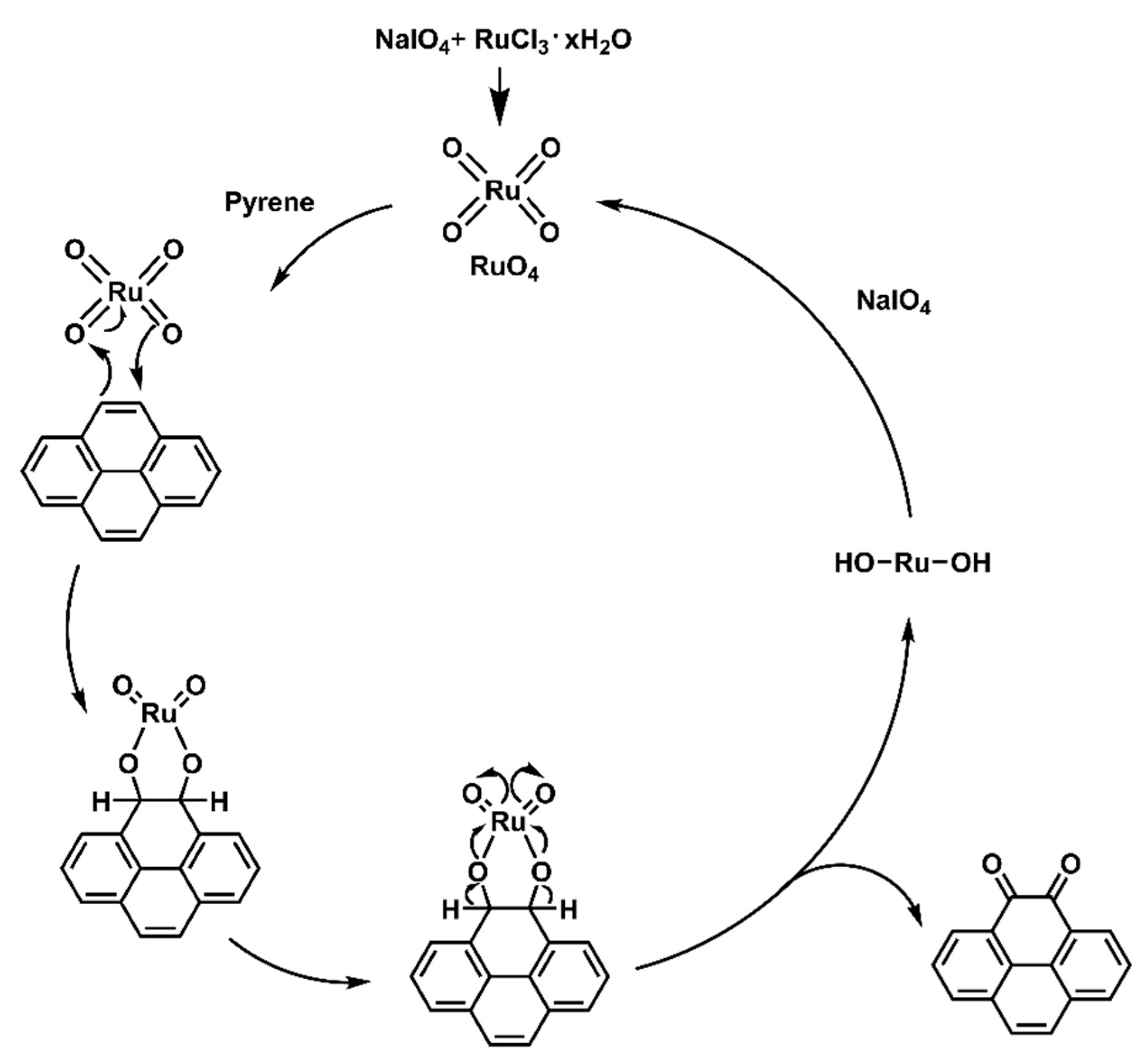
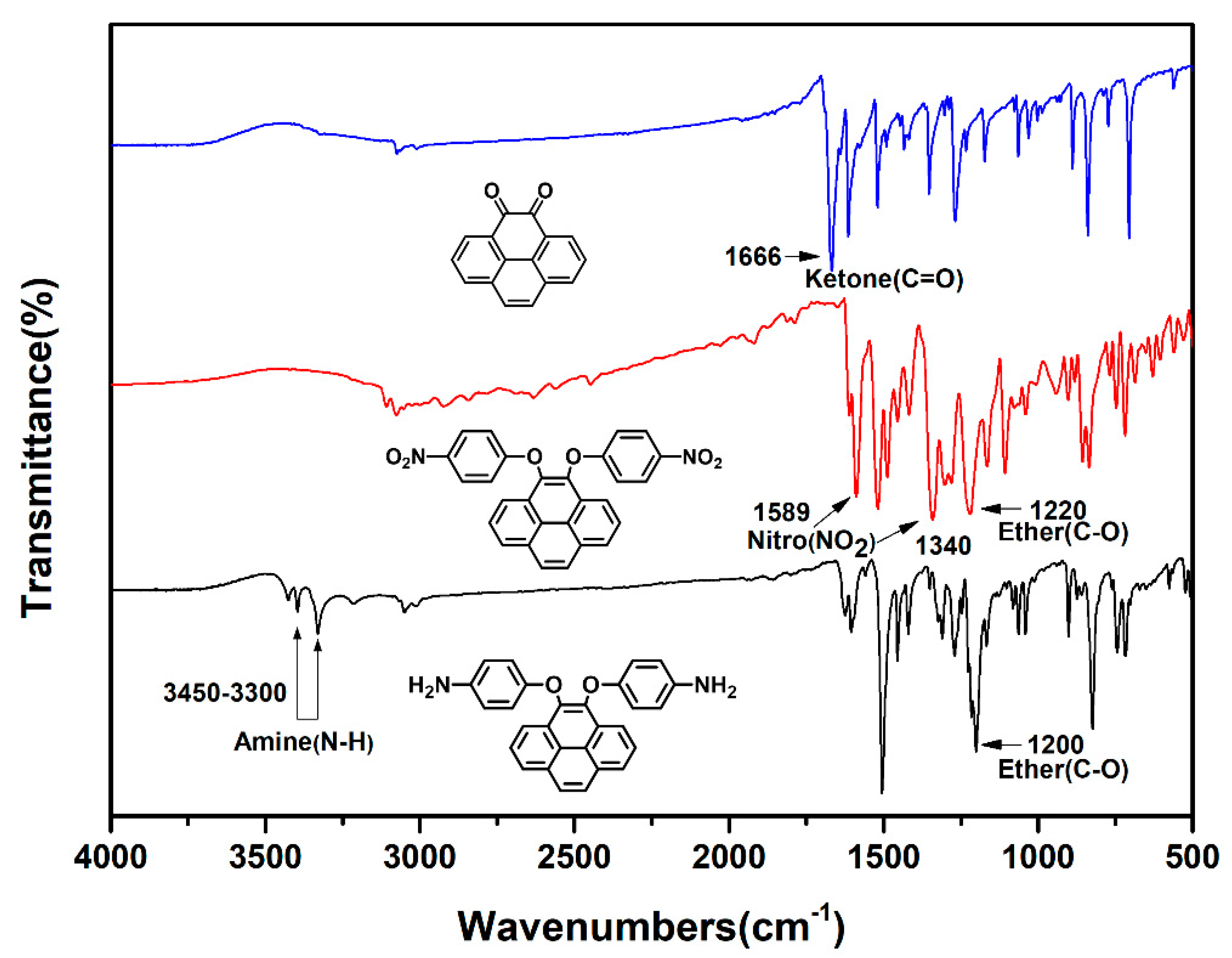
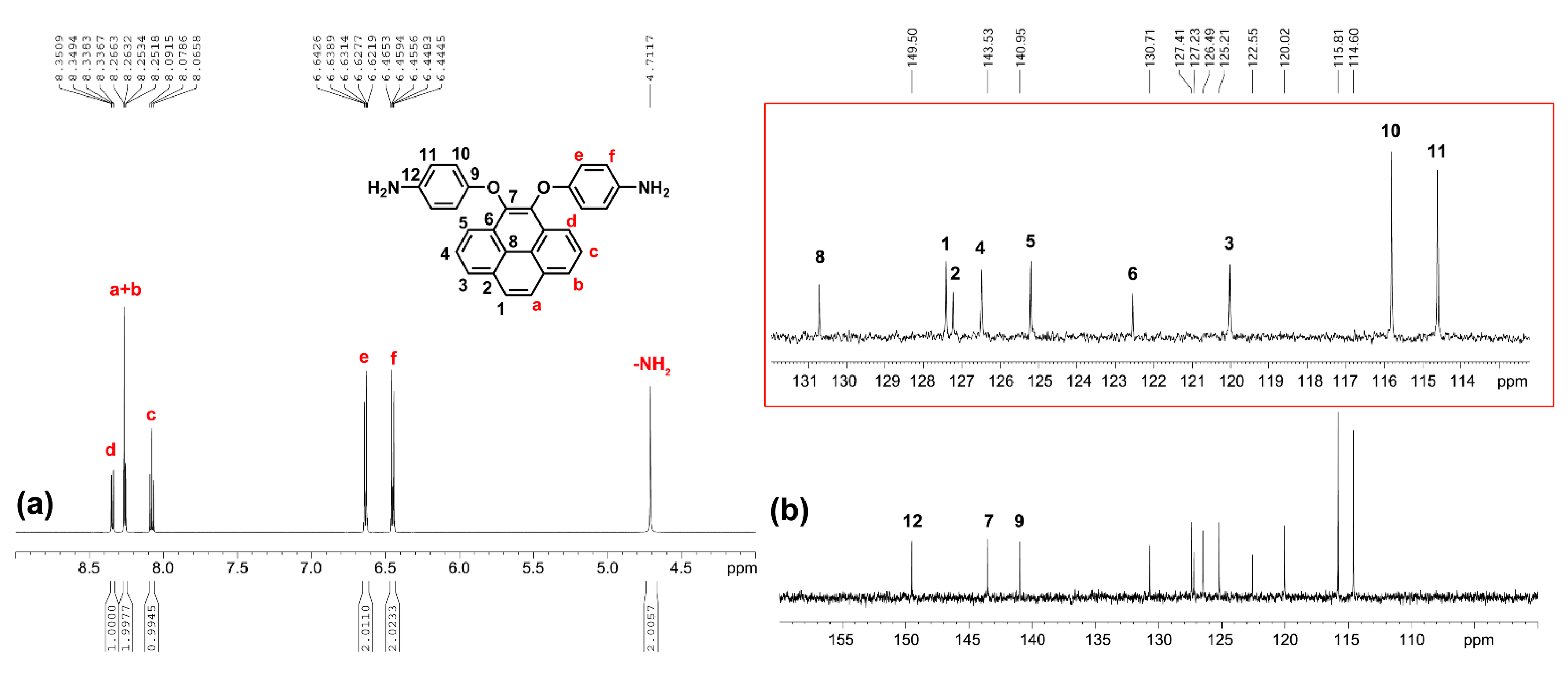


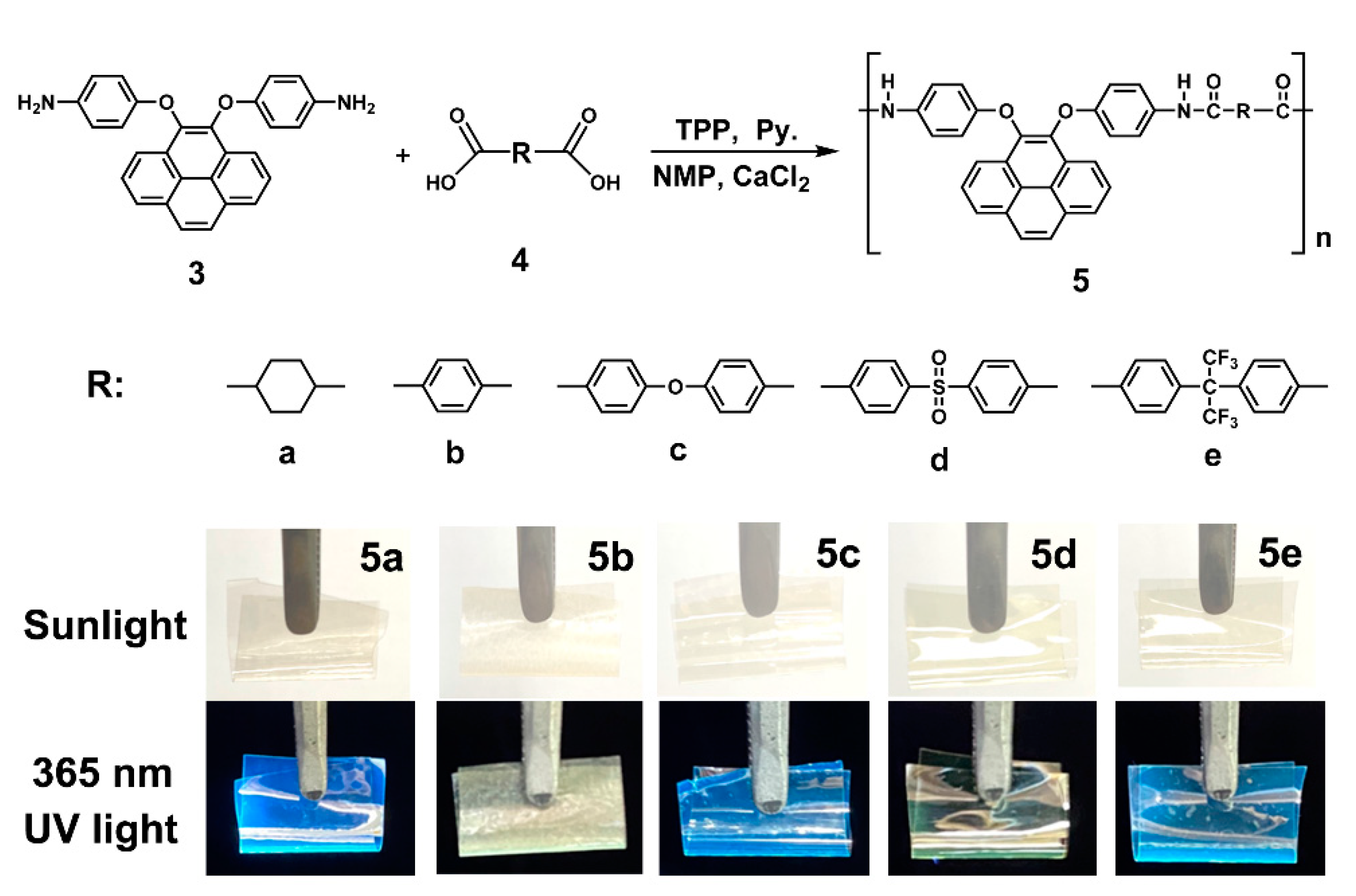




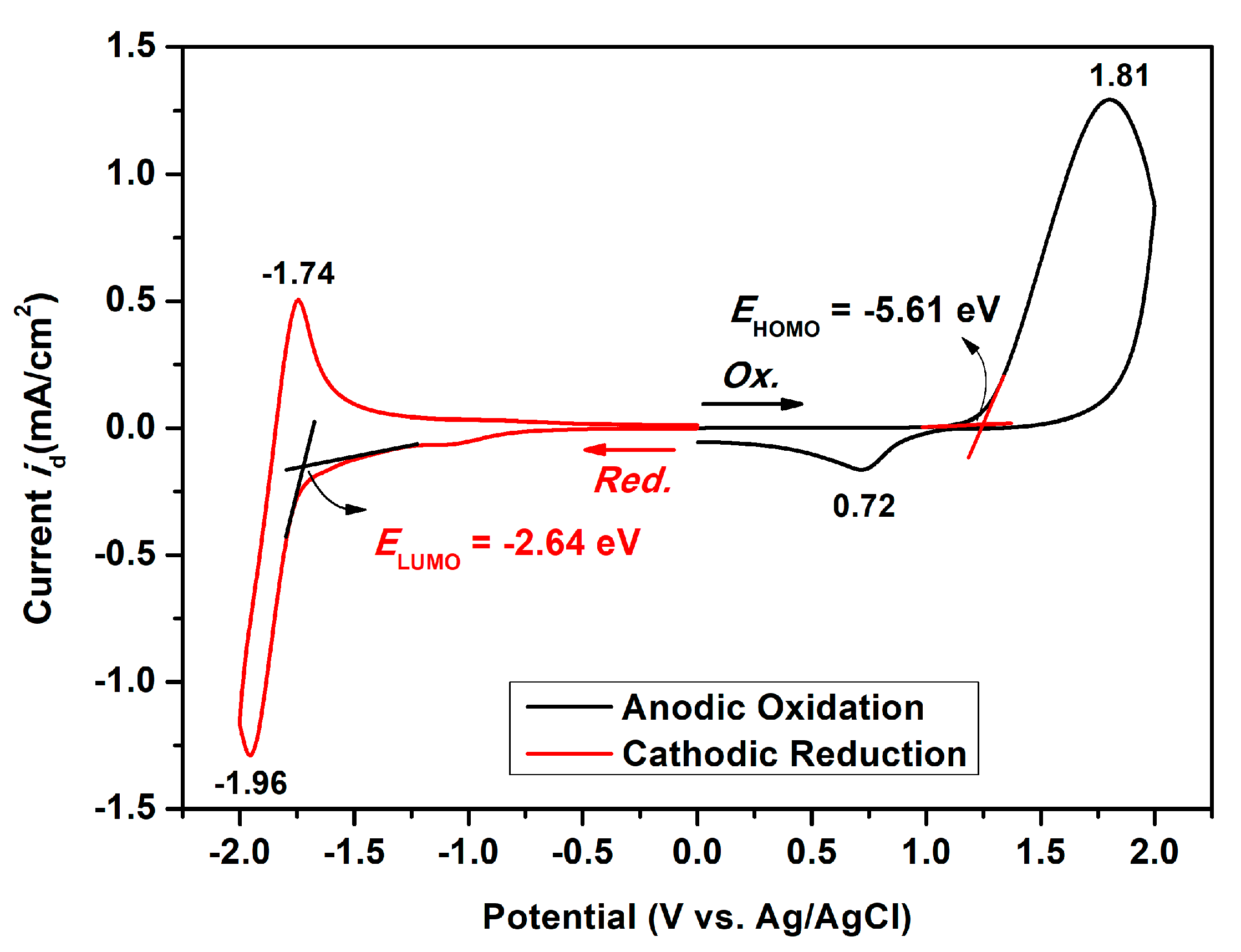

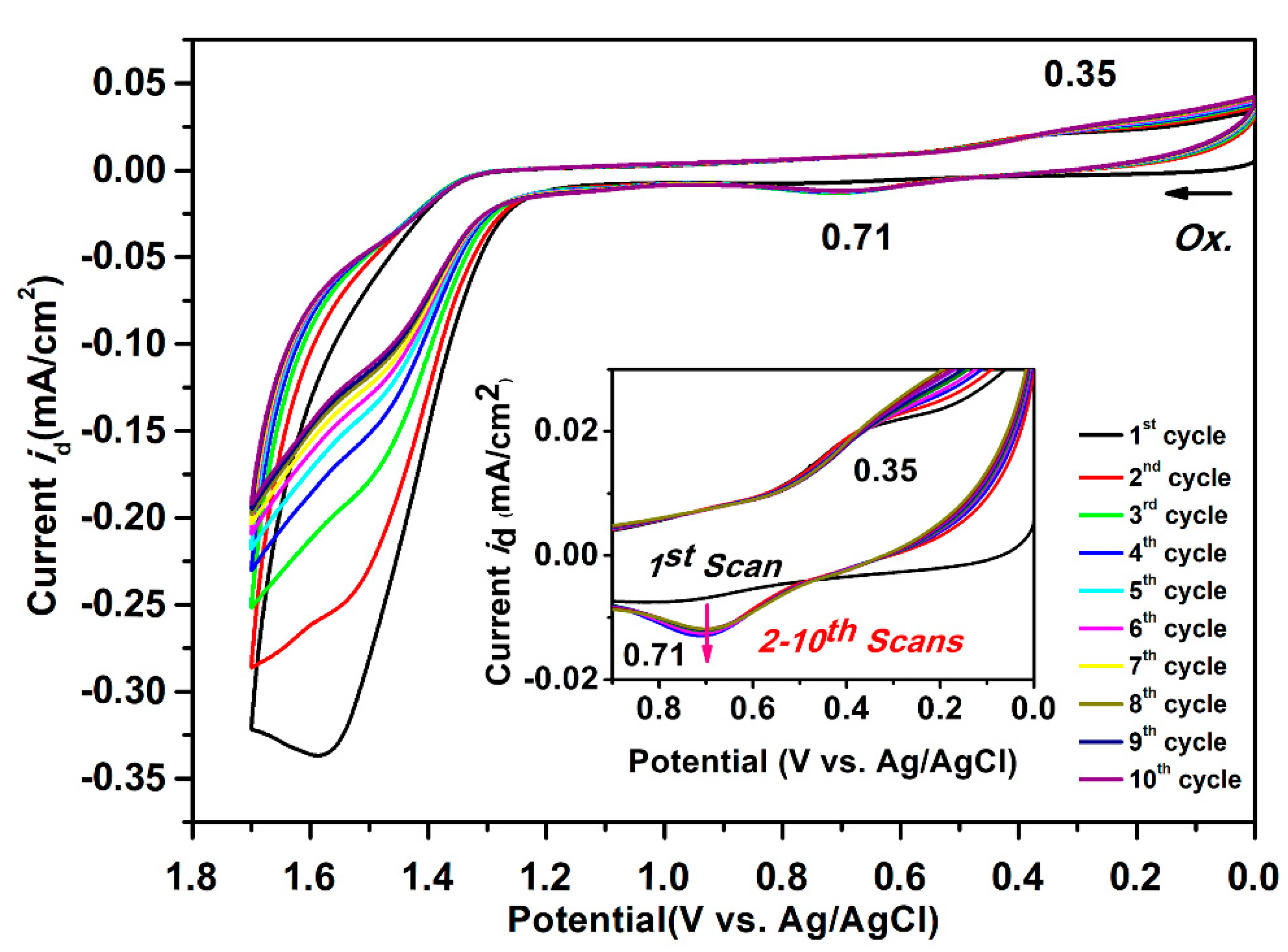


| Polymer Code | ηinh (dL/g) | Various Solvent c | |||||
|---|---|---|---|---|---|---|---|
| NMP | DMAc | DMF | DMSO | m-Cresol | THF | ||
| 5a | 0.61 | ++ (++) | ++ (++) | ++ (++) | ++ (++) | ++ (++) | +− (−) |
| 5b | 0.44 | ++ (++) | +− (++) | +− (++) | +− (++) | − (−) | − (−) |
| 5c | 0.70 | ++ (++) | ++ (++) | ++ (++) | + (++) | ++ (++) | +− (−) |
| 5d | 0.41 | ++ (++) | ++ (++) | ++ (++) | + (++) | ++ (++) | +− (−) |
| 5e | 0.64 | ++ (++) | ++ (++) | ++ (++) | + (++) | ++ (++) | ++ (++) |
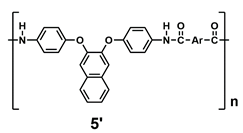 | |||||||
| Polymer Code a | Tgb (°C) | Td 10 wt% Loss c (°C) | Char Yield d (%) | |
|---|---|---|---|---|
| In N2 | In Air | |||
| 5a | 276 (214) e | 485 (481) e | 482 (478) e | 55 (37) e |
| 5b | 310 (255) | 560 (517) | 519 (504) | 74 (69) |
| 5c | 287 (232) | 562 (541) | 549 (529) | 73 (66) |
| 5d | 304 (267) | 544 (505) | 535 (497) | 69 (63) |
| 5e | 294 (264) | 555 (506) | 547 (503) | 69 (62) |
| Polymer | In Solution a | As Solid Film | |||||
|---|---|---|---|---|---|---|---|
| λmax abs (nm) | λmax PL (nm) b | ϕF(%) c | IPyr/Exc d | λmax abs (nm) | λonset abs (nm) | λmax PL (nm) b | |
| 5a | 328, 345 | 381, 400, 487 | 0.41 | 0.13 | 334, 351 | 367 | 446 |
| 5b | 327, 344 | 381, 400, 473 | 0.10 | 0.46 | 334, 351 | 370 | 465 |
| 5c | 327, 344 | 380, 400, 478 | 0.50 | 0.21 | 334, 352 | 367 | 455 |
| 5d | 328, 345 | 382, 399, 476 | 0.10 | 0.45 | 334, 351 | 370 | 473 |
| 5e | 327, 344 | 380, 400, 475 | 0.23 | 0.78 | 332, 350 | 365 | 458 |
| Polymer | Oxidation Potential (V) a | Reduction Potential (V) b | EgCV (eV) c | Egopt (eV) d | HOMO/LUMO (eV) e | |||||
|---|---|---|---|---|---|---|---|---|---|---|
| Eoxonset | Eox1/2 | Eredonset | Ered1/2 | Eonset | E1/2 | Eonset | E1/2 | |||
| 1st | 2nd | |||||||||
| 5a | 1.25 | 1.27 | −1.72 | −1.85 | − | 2.97 | 3.08 | 3.38 | −5.61/−2.64 | −5.59/−2.51 |
| 5b | 1.20 | 1.21 | −1.64 | −1.99 | − | 2.84 | 3.16 | 3.35 | −5.56/−2.72 | −5.53/−2.37 |
| 5c | 1.21 | 1.25 | −1.68 | −1.86 | − | 2.89 | 3.07 | 3.38 | −5.57/−2.68 | −5.57/−2.50 |
| 5d | 1.22 | 1.24 | −1.34 | −1.47 | −1.93 | 2.56 | 2.67 | 3.35 | −5.58/−3.02 | −5.56/−2.89 |
| 5e | 1.21 | 1.24 | −1.68 | −1.97 | − | 2.89 | 3.17 | 3.40 | −5.57/−2.68 | −5.56/−2.39 |
Publisher’s Note: MDPI stays neutral with regard to jurisdictional claims in published maps and institutional affiliations. |
© 2022 by the authors. Licensee MDPI, Basel, Switzerland. This article is an open access article distributed under the terms and conditions of the Creative Commons Attribution (CC BY) license (https://creativecommons.org/licenses/by/4.0/).
Share and Cite
Chen, S.-H.; Chin, H.-S.; Kung, Y.-R. Synthesis and Excimer Formation Properties of Electroactive Polyamides Incorporated with 4,5-Diphenoxypyrene Units. Polymers 2022, 14, 261. https://doi.org/10.3390/polym14020261
Chen S-H, Chin H-S, Kung Y-R. Synthesis and Excimer Formation Properties of Electroactive Polyamides Incorporated with 4,5-Diphenoxypyrene Units. Polymers. 2022; 14(2):261. https://doi.org/10.3390/polym14020261
Chicago/Turabian StyleChen, Shih-Hsuan, Huai-Sheng Chin, and Yu-Ruei Kung. 2022. "Synthesis and Excimer Formation Properties of Electroactive Polyamides Incorporated with 4,5-Diphenoxypyrene Units" Polymers 14, no. 2: 261. https://doi.org/10.3390/polym14020261
APA StyleChen, S.-H., Chin, H.-S., & Kung, Y.-R. (2022). Synthesis and Excimer Formation Properties of Electroactive Polyamides Incorporated with 4,5-Diphenoxypyrene Units. Polymers, 14(2), 261. https://doi.org/10.3390/polym14020261






